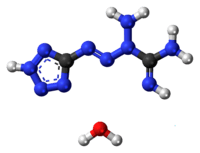Tetrazene explosive
-4-guanyl_tetrazene_hydrate.svg.png) | |
 | |
| Names | |
|---|---|
| IUPAC name
1-(5-tetrazolyl)-3-guanyl tetrazene hydrate | |
| Identifiers | |
| 31330-63-9 | |
| 3D model (Jmol) | Interactive image |
| ECHA InfoCard | 100.128.336 |
| PubChem | 5486788 |
| |
| Properties | |
| C2H6N10·H2O | |
| Molar mass | 188.15 g/mol |
| Appearance | Pale yellow/colorless crystal plates |
| Density | 1.7 g/cm3 |
| Boiling point | Decomposes at 160 °C |
| Explosive data | |
| Shock sensitivity | High |
| Friction sensitivity | High |
| Detonation velocity | ~4000 m/s |
| Except where otherwise noted, data are given for materials in their standard state (at 25 °C [77 °F], 100 kPa). | |
| | |
| Infobox references | |
Tetrazene (1-(5-tetrazolyl)-3-guanyl tetrazene hydrate)[1] is an explosive material used for sensitization of the priming compositions. It is a derivative of the compound with the IUPAC name tetrazene.
Tetrazene is slightly more impact-sensitive than mercury fulminate. When pressed enough, its sensitivity is reduced or destroyed; this is known as dead pressing. It also decomposes in boiling water. In contact with fire, it readily explodes, producing large amounts of black smoke. It is prepared by reacting sodium nitrite with an aminoguanidine salt dissolved in acetic acid at 30–40 °C.
Reactions
Decomposition
The decomposition of tetrazene is quite rapid around 90 °C. A sample of tetrazene was heated in an oven at 90 °C and its rate of thermal decomposition was monitored by infrared and ultraviolet spectroscopy.[2] The thermal decomposition reaction is autocatalytic and it is likely that the same reaction can occur at even lower temperatures, however at much slower rates.
Sensitivity to friction
Many explosives are considered to be highly sensitive to mechanical stimuli such as impact, friction, stab, heat, static electricity, flame, etc. Since explosive compounds are subject to friction practically every time they are handled, it is of particular interest to be aware of the sensitivity to friction. The sensitivity of tetrazene was determined using a FSKM-PEx friction sensitivity tester.[3] The probability of ignition of tetrazene is 100 percent likely at 27N of frictional force.[3]
Hazards
Instances of occupational rhinitis, dermatitis, and asthma have been reported due to prolonged exposure to tetrazene.[4]
References
- "MIL-T-46938C, MILITARY SPECIFICATION: TETRACENE" (PDF). United States Department of Defense. 16 May 1994.
- ↑ Duke, J. R. C. (1971). "X-Ray crystal and molecular structure of 'tetrazene', ('Tetracene'), C2H8N10O". Journal of the Chemical Society D: Chemical Communications. 1971 (1): 2–3. doi:10.1039/C29710000002.
- ↑ Bird, R.; Power, A. (1978). "Thermal Decomposition of Tetrazene at 90°C" (pdf). Melbourne, Victoria: Department of Defence. MRL-R-710 AR-000-886.
- 1 2 Matyáš, R.; Šelešovský, J.; Musil, T. (2012). "Sensitivity to friction for Primary Explosives". Journal of Hazardous Materials. 213–214: 236–41. doi:10.1016/j.jhazmat.2012.01.085. PMID 22349715.
- ↑ Burge, P. S.; Hendy, M.; Hodgson, E. S. (1984). "Occupational asthma, rhinitis, and dermatitis due to tetrazene in a detonator manufacturer". Thorax. 39 (6): 470–1. doi:10.1136/thx.39.6.470. PMC 459834
 . PMID 6235620.
. PMID 6235620.